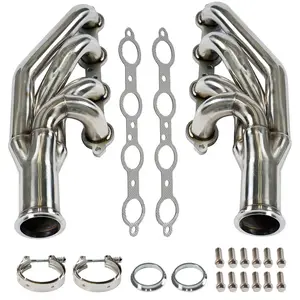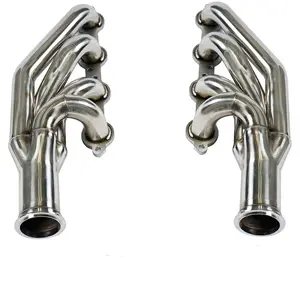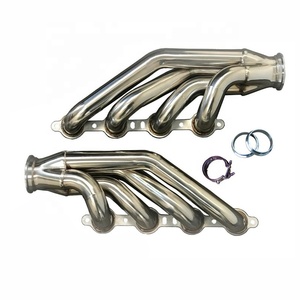(170 products available)



























 Ready to Ship
Ready to Ship
































































































































An LS1 turbo is a type of forced induction gadget used in internal combustion engines. It uses a turbine driven by exhaust gases to compress the incoming air before it enters the engine cylinders. This process increases the air pressure in the intake manifold, allowing more air to flow into the engine, which results in more power. Different types of LS1 turbo kits include the following:
Single Turbo LS1
The LS1 single turbo setup has one turbocharger connected to the engine using a single exhaust pipeline. This design is simpler and doesn't require additional components like twin turbo setups. Single LS1 turbochargers are flexible and can be tuned to achieve different power levels. They also offer improved fuel efficiency when compared to other forced induction systems.
Twin-Turbo LS1
The LS1 twin-turbo setup has two turbochargers linked to the engine, with each turbocharger connected to its own exhaust pipeline. This design allows for better power distribution and quicker turbo spool times. The LS1 twin-turbo setup generates more power than the single turbo setup. It's suitable for high-performance applications, such as racing or track usage.
Turbocharged LS1 Engine
The LS1 turbo engine refers to an LS1 engine that has undergone modifications to enhance its performance using turbocharging. The key components of a turbocharged LS1 engine include the turbocharger, intercooler, exhaust manifold, intake manifold, wastegate, blow-off valve, and customized engine tuning to optimize performance and reliability. Turbocharging significantly boosts the power output of the LS1 engine. The boost levels can be adjusted based on the turbocharger size and the engine's tuning specifications.
Regular Oil Changes
Turbocharged engines generate more heat and stress than naturally aspirated engines. Regular oil changes (every 5,000 miles or as recommended) help protect the turbo. High-quality synthetic oil reduces friction and carries heat away, lubricating critical components. Check the oil level between changes. Low oil can damage the turbo. If the oil light comes on, stop driving immediately. Have the turbo looked at. The oiling system is vital.
Warm-Up and Cool-Down
Always follow the warm-up and cool-down procedures for the turbocharged engine. Before driving, idle the engine for 1-3 minutes. This circulates coolant and protects the turbo. After driving, idle for 1-2 minutes before shutting off. This allows the turbo to cool. Stopping suddenly can cause heat damage over time. The correct warm-up and cool-down extends turbo life.
Air Filter Maintenance
Turbocharged engines rely on clean air for performance. A clogged air filter restricts airflow and reduces efficiency. Check the air filter every 10,000 miles (or as needed). Dirty? Replace or clean it. A clean filter optimizes turbo operation. Protects against dirt entering the engine, too.
Intercooler Inspection
The intercooler cools the compressed air from the turbo before it enters the engine. A faulty intercooler causes overheating and loss of power. Check the intercooler and hoses for leaks, damage, or excessive moisture every 15,000 miles (or as needed). A healthy intercooler maintains turbo performance.
Regular Spark Plug Changes
Turbocharged engines require high-quality spark plugs that can handle the extra strain. Change the spark plugs every 30,000 miles (or per schedule). Use plugs made for turbo use. They ensure smooth combustion under boost. Bad plugs can cause misfires and hurt turbo efficiency.
Monitor Boost Pressure
Boost pressure is how hard the turbo pushes air into the engine. Too low means weak performance. Too high risks engine damage. Use a boost gauge to check if the pressure is just right (as per spec). An incorrectly adjusted wastegate causes boost issues. A pro should tune the wastegate.
Regular Maintenance
Stick to the maintenance schedule in the owner's manual. Do all scheduled tune-ups, fluid changes, and inspections. Preventive care keeps the engine and turbo healthy. Watch for warning signs like check engine lights or loss of power. Catching problems early avoids expensive repairs.
Choosing the right ls1 turbo kit can be daunting for any business buyer. Here are some key factors to consider when choosing an LS1 turbo:
Turbocharger Size
The size of the turbo is one of the most important factors to consider. A larger turbo will produce more power but may have a lag before the boost kicks in. A smaller turbo will spool up quickly but may not provide as much overall power. Consider the desired power band when selecting turbo size.
Compressor Wheel
Check the compressor wheel of the LS1 turbo. Larger wheels move more air but can cause surge in certain applications. Smaller wheels offer more efficiency but limit airflow potential. Find a balanced wheel size for specific goals.
Housing A/R Ratio
The housing A/R ratio impacts how quickly the turbo spools. A lower A/R ratio will result in faster spool times but can limit top-end power. A higher A/R ratio allows for sustained boost at higher RPMs. Choose housing A/R ratio based on whether low-end torque or peak horsepower is prioritized.
Wastegate Type
Select an internal or external wastegate based on tuning needs and space constraints. External wastegates offer more precise boost control but require additional plumbing. Internal wastegates are more compact but may not handle high boost levels as efficiently.
Intercooler Size
Larger intercoolers cool the intake air better but add weight and resistance. A middle-ground intercooler optimally balances cooling needs with engine airflow. Consider how much room is available for intercooler placement as well.
Oil Supply and Drain
Proper oiling is critical for turbo longevity. Look for turbo kits that include filtered oil supply lines and drains to prevent coking. Ensure the LS1 turbo kit chosen has compatible fittings for oil line installation.
Tuning Requirements
All turbos need proper engine tuning for optimal performance and reliability. Determine if the selected turbo kit has tunes available or if custom tuning will be required. Custom tuning adds additional costs and complexity.
Turbocharger replacement is a complex task that requires mechanical knowledge and experience. Attempting a DIY LS1 turbo replacement without the necessary skills may lead to engine damage or safety risks. If unsure, it's best to consult a professional mechanic.
Here's a general guide for replacing an LS1 turbo:
Preparation:
Gather the necessary tools for replacing the LS1 turbo (e.g., socket set, wrenches, torque wrench, etc.). Ensure the new turbocharger is compatible with the LS1 engine. Disconnect the battery before starting any work on the engine.
Removal:
Drain the engine oil and coolant. This will prevent any mess when removing the turbo. Disconnect the intake and exhaust pipes connected to the turbo. This will allow for the removal of the turbo. Unplug any sensors or electrical connections related to the turbo. Remove the oil feed and drain lines connected to the turbo. These lines supply oil to the turbo and drain oil from the turbo.
Turbo Replacement:
Carefully remove the old turbocharger from the exhaust manifold. This may require unbolting the turbo from the manifold. Install the new turbocharger onto the exhaust manifold. Ensure a proper seal to prevent exhaust leaks. Reconnect the oil feed lines to supply oil to the new turbo. Reconnect the oil drain lines to drain oil from the turbo back into the oil pan.
Reassembly:
Reconnect any electrical connections or sensors related to the turbo. Reconnect the intake pipes, ensuring there are no leaks or loose connections. Inspect and replace any gaskets or seals as needed to prevent leaks. Reconnect the cooling lines to the turbo, following the correct routing. Refill the engine oil and coolant to the appropriate levels.
Testing:
Start the engine and allow it to idle for a few minutes. Check for any oil or coolant leaks around the turbo and associated lines. Take the vehicle for a test drive, monitoring the turbo's performance and checking for any unusual sounds or issues.
Q1: What does LS stand for in the engine?
A1: The term ""LS"" does not have any specific meaning regarding its use in engines. However, it is used to refer to ""luxury sport"" or ""light truck"". In most cases, people use the term LS to refer to the engine code when talking about the engine.
Q2: How does the LS1 engine work?
A2: The LS1 engine is a 5.3-liter V8 piston engine that was used in many large trucks and vans. The engine sucked air through the front grille, and the air was filtered through a paper element in the air cleaner. The filtered air would flow through the throttle body into the intake manifold and distribute it to the cylinders. The intake manifold also contained a water passage that allowed it to warm up the incoming air.
Q3: What is the LS1 turbo kit?
A3: An LS1 turbo kit is a collection of parts designed to add a turbocharger to an LS1 engine. The kit usually contains a turbocharger, exhaust manifold, downpipe, intercooler, piping, wastegate, blow-off valve, oil feed and return lines, and other necessary fittings and hardware.
Q4: What are the benefits of turbocharging an LS1 engine?
A4: Turbocharging an LS1 engine can result in significant gains in horsepower and torque. The increased airflow and compression from the turbo can allow for more fuel to be injected, leading to a more powerful and efficient combustion process. This means the LS1 engine can produce more power without major internal engine modifications.